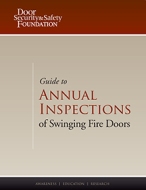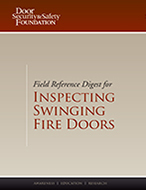Annual Inspection Guides for Swinging Fire Doors
|

Price: $50.00
Purchase
|
Guide to Annual Inspections of Swinging Fire Doors
This guide includes an overview of the requirements in NFPA 80 and NFPA 101 and helps readers understand how and why compliance protects fire door assemblies in buildings. This step-by-step guide gives the AHJ detailed instructions for determining if fire doors comply with NFPA 80 requirements. For the facility manager it clarifies maintenance and inspection requirements of NFPA 80 and describes the owner’s responsibilities for maintaining fire door assemblies in working condition, which is essential for fire and life safety. Chapters include information on inspection cycles, guidelines, reports and record keeping, inspector qualifications, responsibilities and training, performing inspections and sample forms and a glossary of important terms.
|
|

Price: $40.00
Purchase
|
Field Reference Digest for Inspecting Swinging Fire Doors
This digest helps anyone tasked with performing safety inspections by providing the fundamental level of knowledge and understanding of swinging fire doors with builders hardware and the inspection requirements. Additionally it will assist in determining if they are equipped to perform the inspections and testing, or if they need the services of a professional fire door assembly inspector. Chapters include step-by-step instructions for accurately evaluating swinging fire doors with builders’ hardware, plus explanations of NFPA 80 inspection requirements, inspector qualifications, and performing the functional tests.
|
| Discounts are available to purchase 10 or more of each title, contact twaddell@dhi.org for details. |
Locate a CFDAI Professional
Inspections must be performed by individuals knowledgeable about the operating components of doors subject to testing. Locate a CFDAI professional who is certified to perform these inspections.
Opening the Door to School Safety
Several temporary door locking devices, or barricade devices, have been made available with the intention of providing protection for students while in the classroom. Unfortunately, these products fall short of the code requirements and often lead to unintended consequences. There are already solutions in place in most schools, and experts can help confirm if your school is safe and secure. Visit our Advocacy page or our new website dedicated to this campaign, www.lockdontblock.org, to view our video and access many types of resources about this important issue, including fact sheets, white papers, videos, statistics, and more. We encourage you to share this information with your colleagues and your communities.
Fire and Egress Door Assembly Inspection Program
The Door and Hardware Institute (DHI) developed the Certified Fire and Egress Door Assembly Inspection (CFDAI) Program to assist Authorities Having Jurisdiction (AHJs) and building owners in the inspection process. Specifically, DHI has created a training program that provides students with door, frame and hardware product and application knowledge as well as concentrating on NFPA 80’s inspection requirements, including important proper documentation practices.
For more information on the Fire and Egress Door Assembly Inspection Program, go to www.dhi.org.
Door Assembly Inspection of Fire, Smoke and Egress Door Openings
Inspection points for swinging fire doors with builders hardware per NFPA 80 2013 Edition, smoke doors per NFPA 105 2010 Edition and egress doors per NFPA 101 2015 Edition, with fire-rated and non-rated door assemblies, and the 10 most common deficiencies found on swinging fire doors.
Download Door Assembly Inspection Sheet PDF
Performing these steps does not replace the training that is available to become a knowledgeable fire door inspector as required by NFPA 80. These steps are provided as one way to consistently perform a fire door inspection. The Authority Having Jurisdiction determines an acceptable level of knowledge to perform these inspections.
Building Code Adoptions by State
The International Code Council (ICC) develops the codes used to construct residential and commercial buildings—including government buildings, hotels, schools, and healthcare. This council also serves as the basis for the construction of federal properties around the world, as well as in most U.S. cities, counties, and states.
The most relevant codes for the openings industry fall under the International Building Codes (IBC). These codes are used during the construction phase and are referenced until the Certificate of Occupancy is issued. International Fire Codes (IFC) are used for existing buildings.
The 2009 editions of both the IBC and the IFC reference the inspection steps contained in NFPA 80 (2007 edition). If a state has adopted the 2009 version of the IBC or IFC, then, in theory, they could be performing inspections based on enforcement by the local AHJ community.
Links below direct you to interactive resources offered by the International Code Council.
- U.S. Map lists the codes in use for that state. When you click on a state, you will be looking for '2009 International Building Code' and/or '2009 International Fire Code.'
- U.S. Code Adoptions Map highlights codes that are in use for each individual state. Under the IBC column or IFC column you, will be looking for the adoption of the '2009 edition.’